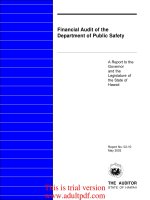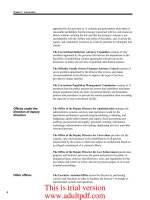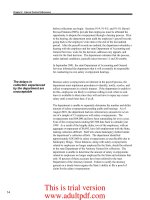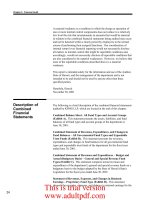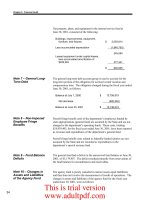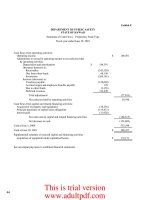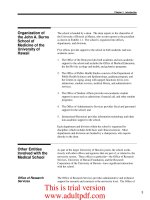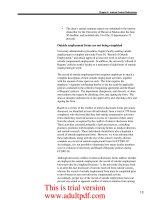Financial Audit of the John A. Burns School of Medicine of the University of Hawaii A Report to the Governor and the Legislature of the State of Hawaii Report No. 03-02 May 2002_part3 pdf
Bạn đang xem bản rút gọn của tài liệu. Xem và tải ngay bản đầy đủ của tài liệu tại đây (41.97 KB, 11 trang )
15
Chapter 3: Financial Audit
Chapter 3
Financial Audit
This chapter presents the results of the financial audit of the John A.
Burns School of Medicine of the University of Hawaii, as of and for the
fiscal year ended June 30, 2002. This chapter includes the independent
auditors’ report and the report on compliance and internal control over
financial reporting based on an audit of financial statements performed in
accordance with Government Auditing Standards as they relate to the
school. It also displays the school’s financial statements together with
explanatory notes.
In the opinion of Deloitte & Touche LLP, based on their audit, the
financial statements present fairly, in all material respects, the financial
position of the school as of June 30, 2002, and the changes in its
financial position and its cash flows for the year then ended in
conformity with accounting principles generally accepted in the United
States of America. Deloitte & Touche LLP noted that the school has not
presented the management’s discussion and analysis information that the
Government Accounting Standards Board has determined is necessary to
supplement, although not required to be part of, the basic financial
statements. Deloitte & Touche LLP also noted that the results of its tests
disclosed no instances of noncompliance that are required to be reported
under Government Auditing Standards.
The Auditor
State of Hawaii:
We have audited the statement of net assets of the John A. Burns School
of Medicine of the University of Hawaii (school) as of June 30, 2002,
and the related statements of revenues, expenses, and changes in net
assets and of cash flows for the year then ended. These financial
statements are the responsibility of the school’s management. Our
responsibility is to express an opinion on these financial statements
based on our audit.
We conducted our audit in accordance with auditing standards generally
accepted in the United States of America and the standards applicable to
financial audits contained in Government Auditing Standards, issued by
the Comptroller General of the United States. Those standards require
that we plan and perform the audit to obtain reasonable assurance about
Summary of
Findings
Independent
Auditors’ Report
This is trial version
www.adultpdf.com
16
Chapter 3: Financial Audit
whether the financial statements are free of material misstatement. An
audit includes examining, on a test basis, evidence supporting the
amounts and disclosures in the financial statements. An audit also
includes assessing the accounting principles used and the significant
estimates made by management, as well as evaluating the overall
financial statement presentation. We believe that our audit provides a
reasonable basis for our opinion.
As discussed in Note 1, the financial statements of the school are
intended to present the financial position, and the changes in financial
position and cash flows of only that portion of the activities of the
University of Hawaii that are attributable to the transactions of the
school. They do not purport to, and accordingly do not, present fairly the
financial position of the University of Hawaii as of June 30, 2002, and
the changes in its financial position and its cash flows for the year then
ended in conformity with accounting principles generally accepted in the
United States of America.
In our opinion, the financial statements referred to above present fairly,
in all material respects, the financial position of the school as of June 30,
2002, and the changes in its financial position and its cash flows for the
year then ended in conformity with accounting principles generally
accepted in the United States of America.
As discussed in Note 1 to the financial statements, the school has
implemented a new financial reporting model, as required by the
provisions of the Governmental Accounting Standards Board Statement
No. 34, Basic Financial Statements—and Management’s Discussion and
Analysis—for State and Local Governments, and Governmental
Accounting Standards Board Statement No. 35, Basic Financial
Statements—and Management’s Discussion and Analysis—for Public
Colleges and Universities, as of June 30, 2002.
The school has not presented the management’s discussion and analysis
information that the Governmental Accounting Standards Board has
determined is necessary to supplement, although not required to be part
of, the basic financial statements.
In accordance with Government Auditing Standards, we have also issued
our report dated October 28, 2002 on our consideration of the school’s
internal control over financial reporting and our tests of its compliance
with certain provisions of laws, regulations, contracts, and grants. That
report is an integral part of an audit performed in accordance with
Government Auditing Standards and should be read in conjunction with
this report in considering the results of our audit.
This is trial version
www.adultpdf.com
17
Chapter 3: Financial Audit
/s/Deloitte & Touche LLP
Honolulu, Hawaii
October 28, 2002
The Auditor
State of Hawaii:
We have audited the financial statements of the John A. Burns School of
Medicine of the University of Hawaii (school) as of and for the year
ended June 30, 2002, and have issued our report thereon dated October
28, 2002. We conducted our audit in accordance with auditing standards
generally accepted in the United States of America and the standards
applicable to financial audits contained in Government Auditing
Standards, issued by the Comptroller General of the United States.
Compliance
As part of obtaining a reasonable assurance about whether the school’s
financial statements are free of material misstatement, we performed
tests of its compliance with certain provisions of laws, regulations,
contracts, and grants, noncompliance with which could have a direct and
material effect on the determination of financial statement amounts.
However, providing an opinion on compliance with those provisions was
not an objective of our audit and accordingly, we do not express such an
opinion. The results of our tests disclosed no instances of
noncompliance that are required to be reported under Government
Auditing Standards.
Internal Control Over Financial Reporting
In planning and performing our audit, we considered the school’s
internal control over financial reporting in order to determine our
auditing procedures for the purpose of expressing our opinion on the
financial statements and not to provide assurance on the internal control
over financial reporting. Our consideration of the internal control over
financial reporting would not necessarily disclose all matters in the
internal control over financial reporting that might be material
weaknesses. A material weakness is a condition in which the design or
operation of one or more of the internal control components does not
reduce to a relatively low level the risk that misstatements in amounts
that would be material in relation to the financial statements being
audited may occur and not be detected within a timely period by
Report on
Compliance and
on Internal Control
Over Financial
Reporting Based
on an Audit of
Financial
Statements
Performed in
Accordance with
Government
Auditing
Standards
This is trial version
www.adultpdf.com
18
Chapter 3: Financial Audit
employees in the normal course of performing their assigned functions.
We noted no matters involving the internal control over financial
reporting and its operation that we consider to be material weaknesses.
This report is intended solely for the information and use of the Auditor,
State of Hawaii, and the management of the school and is not intended to
be and should not be used by anyone other than these specified parties.
/s/Deloitte & Touche LLP
Honolulu, Hawaii
October 28, 2002
The following is a brief description of the financial statements audited by
Deloitte & Touche LLP, which are presented at the end of this chapter.
This statement presents the assets, liabilities, and net assets of the school
at June 30, 2002.
This statement presents the revenues, expenses, and changes in net assets
for the school for the year ended June 30, 2002.
This statement presents the cash flows from operating, non-capital
financing, capital and related financing, and investing activities of the
school for the year ended June 30, 2002.
Explanatory notes that are pertinent to an understanding of the financial
statements and financial condition of the school are discussed in this
section.
General
The John A. Burns School of Medicine of the University of Hawaii
(school) was established in 1965 originally as a two-year medical school
with two primary objectives:
• To provide opportunities for Hawaii’s citizens to have access to
careers in medicine equivalent to those available in other states;
and
Description of
Financial
Statements
Statement of Net
Assets (Exhibit 3.1)
Statement of
Revenues, Expenses,
and Changes in Net
Assets (Exhibit 3.2)
Statement of Cash
Flows (Exhibit 3.3)
Notes to Financial
Statements
Note 1 - Summary of
Significant Accounting
Policies
This is trial version
www.adultpdf.com
19
Chapter 3: Financial Audit
• To add to the stature, academic quality, and research potential of
the University of Hawaii (university).
The school converted to a four-year M.D. degree-granting institution and
graduated its first class in 1975. The school’s major emphasis is to train
students to a high level of competence as physicians for the state and
region and to conduct cutting-edge biomedical research, with the goal of
improving health care in Hawaii and the Pacific area. The school offers
an innovative and progressive problem-based curriculum, called the
“M.D. Program,” which is designed to integrate relevant basic science
with clinical material using actual cases.
The school operates administratively as a unit of the university’s Manoa
campus. The school is a community-based medical school that does not
own its own teaching hospital, but bases its clinical instruction in
affiliated community hospitals and clinics across the state of Hawaii.
Financial Reporting Entity and Basis of Presentation
Under the provisions of Governmental Accounting Standards Board
(GASB) Statement No. 14, The Financial Reporting Entity, the
university is considered a component unit of the State of Hawaii, its
primary government, and is included in the state’s basic financial
statements. However, the university is also its own reporting entity in
accordance with GASB Statement No. 14, and has determined that the
Research Corporation of the University of Hawaii (RCUH) and the
University of Hawaii Foundation (foundation) are its component units,
included in the university’s financial statements. The basic criterion for
determining whether a potential component unit should be reported
within a reporting entity is financial accountability. Other criteria,
including fiscal dependency and the nature and significance of the
relationship, are such that exclusion would cause the financial statements
to be misleading.
GASB Statement No. 14 is applicable to the following types of
governmental entities:
• Primary governments;
• Governmental joint ventures;
• Jointly governed organizations;
• Stand-alone governments; and
• Component units.
This is trial version
www.adultpdf.com
20
Chapter 3: Financial Audit
The school is a part of the University of Hawaii and is not one of the
governmental entity types subject to the provisions of GASB Statement
No. 14. However, for consistency with the university’s financial
statements, the school has elected to apply the general provisions of
GASB Statement No. 14 in defining its reporting entity for its stand-
alone financial statements. Certain financial information related to the
school’s activities is reflected in accounts under RCUH and the
foundation. This information has been blended in the accompanying
financial statements. Financial information of the Office of Public
Health Studies (formerly known as the School of Public Health Studies
prior to being organizationally consolidated under the school in FY2000-
01) and of certain school research project accounts managed
administratively by the university’s Pacific Biomedical Research Center
has also been blended in the accompanying financial statements.
In November 1999 and June 1999, GASB issued its Statement No. 35,
Basic Financial Statements—and Management’s Discussion and
Analysis—for Public Colleges and Universities, and Statement No. 34,
Basic Financial Statements—and Management’s Discussion and
Analysis—for State and Local Governments, respectively, which became
effective for the university for the fiscal year ended June 30, 2002.
These statements significantly changed the reporting requirements for
public colleges and universities in the United States. Under the
provisions of these statements, the university is permitted to report as a
special-purpose government engaged only in business-type activities
(BTA reporting), because it is financed in part by fees charged to
external parties for goods and services. BTA reporting requires the
presentation of only basic financial statements (fund financial statements
are not required) and required supplementary information for enterprise
funds, which includes:
• A statement of net assets;
• A statement of revenues, expenses, and changes in net assets;
• A statement of cash flows;
• Notes to the financial statements;
• Management’s discussion and analysis; and
• Required supplementary information other than management’s
discussion and analysis (if applicable).
Significant changes in reporting to comply with the new reporting model
include: recording depreciation on capital assets; reporting revenues net
of discounts and allowances; eliminating interfund activities; classifying
This is trial version
www.adultpdf.com
21
Chapter 3: Financial Audit
activities as either operating or non-operating; and classifying assets and
liabilities as current or non-current. The BTA reporting model provides
that all GASB pronouncements, as well as Financial Accounting
Standards Board pronouncements (except those that conflict with GASB
pronouncements or are intended to be applicable specifically to not-for-
profit organizations or issues primarily concerning such organizations),
be implemented.
Applicability of the new statements extends to state and local
governments as well as public colleges and universities. Reporting
standards are written from the perspective of general-purpose
governments such as states, cities, counties, towns, and villages, but also
provide specific financial reporting standards for special-purpose
governments such as colleges and universities reporting under the BTA
reporting model. As the medical school is a part of the university and
not a separate governmental entity, the provisions of these statements do
not specifically apply to it. However, for consistency with the
university’s financial statements, the school has elected to apply the
general provisions of the BTA reporting model in preparing the school’s
stand-alone financial statements, except for including a Management’s
Discussion and Analysis section as required supplementary information.
The school implemented the provisions of the new reporting model
effective for the fiscal year ended June 30, 2002. The effect of the
changes resulting from implementation of GASB Statement Nos. 34 and
35 has been reflected as a prior period adjustment. Such adjustment had
the effect of reducing net assets at the beginning of the year and net
capital assets by $3,517,473, representing accumulated depreciation to
that date.
Basis of Accounting
The school’s financial statements are prepared using the economic
resources measurement focus and the accrual basis of accounting. Under
the accrual basis, revenues are recognized when earned and expenses are
recorded when a liability is incurred.
Revenue Recognition and Classification
Operating revenues of the school result primarily from providing
services to external parties, and generally have the characteristics of
exchange transactions. Included in operating revenues are contract and
grant revenue from federal, state, and local governments, as well as
private sources and student tuition and fees. In addition,
• Grant and contract revenues and receivables are recorded as
soon as all eligibility requirements imposed by the grantor or
contractor have been met; and
This is trial version
www.adultpdf.com
22
Chapter 3: Financial Audit
• Student tuition and fee revenues are recognized when earned,
and are reported in the accompanying financial statements net of
scholarship discounts and allowances.
Non-operating revenues of the school are normally generated through
non-exchange transactions such as state appropriations, gifts, and
investment income. Specifically,
• State appropriations to the school are allocated by the university
annually. Revenue is recognized by the school based on total
expenditures and commitments made in the year that the funds
are available;
• Gift revenue and contributions receivable is recognized net of
estimated uncollectible amounts when all eligibility
requirements are met;
• The university collects and later allocates school revenues from
tuition and from the facilities and administrative cost recovery
component of grants and contracts. A university allocation is
reported as non-operating revenue equal to the amount allocated
by the university to the school in excess of these school
operating revenues; and
• Investment income (or loss) is comprised of unrealized and
realized gains and losses, interest, dividend, and investment fees
allocated by the university and foundation investment pools.
Cash and Cash Equivalents
The school considers all highly liquid debt instruments, including short-
term cash investments, purchased with an original maturity of three
months or less to be cash equivalents.
The carrying amounts reported in the statement of net assets for cash and
cash equivalents approximate fair value due to the short maturity of these
instruments.
All school cash is held either by the State Treasury or pooled with other
university, foundation, or RCUH cash balances.
Accounts Receivable
Accounts receivable consists primarily of amounts due to the school
from the federal government, state and local governments, and private
sources in connection with the reimbursement of allowable expenditures
made pursuant to contracts and grants. Accounts receivable are reported
net of estimated uncollectible amounts.
This is trial version
www.adultpdf.com
23
Chapter 3: Financial Audit
The school uses the specific identification method to record its
allowance for doubtful accounts.
Prepaid Expenses
Prepaid expenses are amounts paid to vendors or suppliers as of the
fiscal year-end prior to receipt of the associated goods or services.
Investments
Investments of the school consist primarily of endowment investments
that are stated at fair value, as determined by quoted market prices, or
amounts determined by management if quoted market prices are not
available. The net change in the fair value of investments is recognized
as a component of investment income or loss.
Investments of the school’s endowment funds are combined in
investment pools with the university and foundation, unless required by
the donor to be separately invested. Individual endowments subscribe to
or dispose of units in the pools on the basis of a per unit valuation of the
pool fair value. Gains or losses on sales of investments are retained or
absorbed by the endowment principal. Cost of securities sold is
determined using the first-in, first-out method.
The Board of Regents of the university and the Board of Directors of the
foundation (collectively, the “boards”) are responsible for management
of the school’s endowment investments. The boards establish
investment goals and comprehensive guidelines to ensure the
preservation of capital and adequate growth and income. The boards and
appointed investment managers perform regular monitoring of
investment performance. Title to investment securities is vested in the
name of the Securities and Exchange Commission registered brokerage
firms in New York representing the various investment managers of the
university and the foundation.
The university’s and foundation’s policies provide for the distribution to
the school of up to 5 percent of the preceding year’s endowment fair
value. If a donor has not provided specific instructions, state law permits
the boards to authorize for expenditure the net appreciation of the
investments of the endowment funds. Any net appreciation spent is
required to be used for the purposes for which the endowment was
established.
Capital Assets
Capital assets are recorded at cost on the date of acquisition, or if
donated, at appraised value on the date of donation. The school’s policy
is to capitalize tangible, non-expendable personal property having an
This is trial version
www.adultpdf.com
24
Chapter 3: Financial Audit
estimated useful life of more than one year and an acquisition cost of
$5,000 or more per item. Items with acquisition costs under $5,000 are
reflected as equipment expenses on the statement of revenues, expenses,
and changes in net assets. Depreciation on the school’s capital assets is
computed using the straight-line method over the estimated useful lives
of the assets. The school’s capital assets are mainly comprised of
furniture, fixtures, and equipment with useful lives ranging from three to
ten years. Capital assets retired or otherwise disposed of are removed
from the appropriate asset and related accumulated depreciation
accounts. Gains and losses on disposals are reflected as non-operating
income or expense.
Certain capital assets held under capital lease are amortized using the
straight-line method over the lease term, and the related obligations are
reported as liabilities in the statement of net assets. Lease amortization
is included in depreciation expense.
Land and buildings on which school facilities are located and related
infrastructure assets are not reflected in the financial statements of the
school, but are reported in the university’s financial statements.
Accounts Payable
Accounts payable represent the cost of goods or services received that
have not been paid for as of year-end.
Deferred Revenues
Deferred revenues are reported as liabilities on the statement of net
assets and include amounts primarily received for grants and contracts
that have not yet been earned as of year-end.
Due to University of Hawaii
Amounts due to the university are comprised of advances made by the
university to finance the cost of the school’s extramurally sponsored
projects for which funds are received from sponsoring agencies on a cost
reimbursement basis. Pay down of this balance is generally recorded
simultaneously with the receipt of the school’s outstanding accounts
receivable from sponsoring agencies.
Net Assets
The school’s net assets are classified as follows:
Invested in Capital Assets, Net of Related Debt
This component of net assets represents the school’s total investment in
capital assets, net of accumulated depreciation and outstanding debt
obligations related to those capital assets.
This is trial version
www.adultpdf.com
25
Chapter 3: Financial Audit
Restricted Net Assets – Nonexpendable
Nonexpendable restricted net assets include endowments and similar
type assets that are subject to externally imposed constraints and
required to be maintained in perpetuity.
Restricted Net Assets – Expendable
Expendable restricted net assets include resources whose use is legally or
contractually subject to externally imposed constraints.
Unrestricted Net Assets
Unrestricted net assets represent all other net assets not classified as
restricted or invested in capital assets. These resources are derived
primarily from student tuition and fees, state appropriations, and gifts.
When an expense is incurred for purposes for which both restricted and
unrestricted net assets are available, resources are generally applied
proportionate to the benefit realized. For instances in which such a
determination is not feasible or if there are cost compliance issues,
unrestricted resources are applied first.
Internal Activities
All amounts and account balances resulting from activities occurring
among the school, RCUH, foundation, and university have been
eliminated from the accompanying financial statements.
Management’s Estimates
The preparation of financial statements in conformity with accounting
principles generally accepted in the United States of America requires
management to make estimates and assumptions that affect the reported
amounts of assets and liabilities and disclosure of contingent assets and
liabilities at the date of the financial statements and the reported amounts
of revenues and expenses during the reporting period. Actual results
could differ from those estimates.
All school cash and cash equivalents are held either by the State
Treasury or pooled with other university, foundation, or RCUH cash
balances.
At June 30, 2002, information related to the insurance and collateral of
funds deposited with the State Treasury was not available, since such
information is determined on a statewide basis and not for individual
departments. Cash deposits with the State Treasury are either federally
insured or collateralized with obligations of the state or U.S.
government. All securities pledged as collateral are held either by the
State Treasury or by the State’s fiscal agents in the name of the State.
Note 2 - Cash and Cash
Equivalents
This is trial version
www.adultpdf.com
